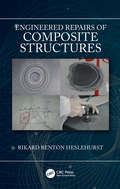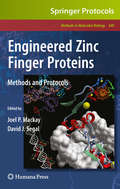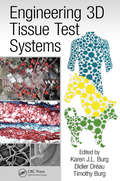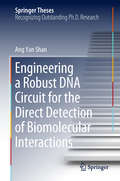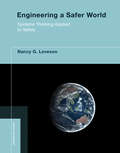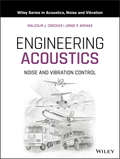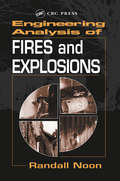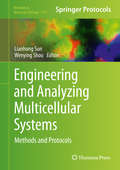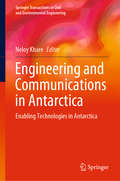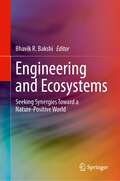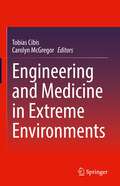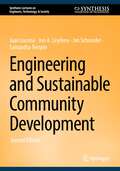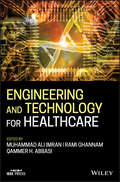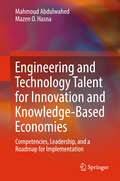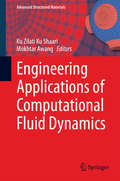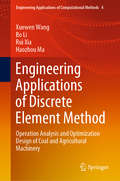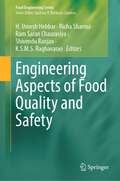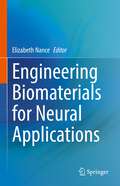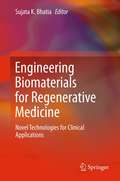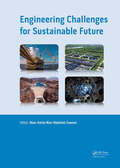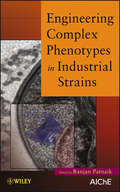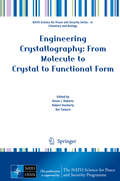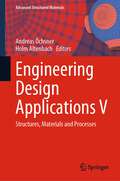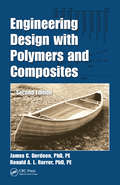- Table View
- List View
Engineered Repairs of Composite Structures
by Rikard Benton HeslehurstEngineered Repairs of Composite Structures provides a detailed discussion, analysis, and procedures for effective and efficient repair design of advanced composite structures. It discusses the identification of damage types and the effect on structural integrity in composite structures, leading to the design of a repair scheme that focusses on the restoration of the structural integrity and damage tolerance. This book teaches the reader to better understand effective and efficient repair design, allowing for more structurally effective repairs of damaged composite structures. It also discusses the application of the repair and what is needed in the forming of the composite repair to meet the engineering design requirements. Aimed at materials engineers, mechanical engineers, aerospace engineers, and civil engineers, this practical work is a must have for any industry professional working with composite structures.
Engineered Zinc Finger Proteins
by Joel P. Mackay David J. SegalAmong the many types of DNA binding domains, C2H2 zinc finger proteins (ZFPs) have proven to be the most malleable for creating custom DNA-binding proteins. In Engineered Zinc Finger Proteins: Methods and Protocols, expert researchers from some of the most active laboratories in this field present detailed methods, guidance, and perspectives. The volume contains sections covering the engineering of ZFPs, methods for the creation, evaluation, and delivery of artificial transcription factors (ATFs), methods for the creation and evaluation of zinc finger nucleases (ZFNs), and a collection of the several applications and assays beyond ATFs and ZFNs, including zinc finger transposases and ChIP-seq methodology amongst other subjects. Written in the highly successful Methods in Molecular BiologyTM series format, chapters include introductions to their respective topics, lists of the necessary materials and reagents, step-by-step, readily reproducible laboratory protocols, and notes on troubleshooting and avoiding known pitfalls. Comprehensive and cutting-edge, Engineered Zinc Finger Proteins: Methods and Protocols aims to aid both seasoned practitioners and new investigators with its vital methods and insights as they seek to create the next generation of engineered ZFPs and applications.
Engineering 3D Tissue Test Systems
by Karen J. L. Burg, Didier Dréau and Timothy BurgEngineering 3D Tissue Test Systems provides an introduction to, and unique coverage of, a rapidly evolving area in biomaterials engineering. It reveals the current and future research responses, the current and future diagnostic applications, and provides a comprehensive overview to foster innovation. It offers insight into the importance of 3D systems and their use as benchtop models, spanning applications from basic scientific research to clinical diagnostics. Methods and limitations of building 3D tissue structures are evaluated, with attention given to the cellular, polymeric, and fabrication instrumentation components. The book covers the important aspects of polymeric tissue test systems, highlighting the needs and constraints of the industry, and includes a chapter on regulatory and pricing issues.
Engineering a Robust DNA Circuit for the Direct Detection of Biomolecular Interactions (Springer Theses)
by Ang Yan ShanThis book provides essential insights into designing a localized DNA circuit to promote the rate of desired hybridization reactions over undesired leak reactions in the bulk solution. The area of dynamic DNA nanotechnology, or DNA circuits, holds great promise as a highly programmable toolbox that can be used in various applications, including molecular computing and biomolecular detection. However, a key bottleneck is the recurring issue of circuit leakage. The assembly of the localized circuit is dynamically driven by the recognition of biomolecules – a different approach from most methods, which are based on a static DNA origami assembly. The design guidelines for individual reaction modules presented here, which focus on minimizing circuit leakage, are established through NUPACK simulation and tested experimentally – which will be useful for researchers interested in adapting the concepts for other contexts. In the closing section, the design concepts are successfully applied to the biomolecular sensing of a broad range of targets including the single nucleotide mutations, proteins, and cell surface receptors.
Engineering a Safer World: Systems Thinking Applied to Safety (Engineering Systems)
by Nancy G. LevesonA new approach to safety, based on systems thinking, that is more effective, less costly, and easier to use than current techniques.Engineering has experienced a technological revolution, but the basic engineering techniques applied in safety and reliability engineering, created in a simpler, analog world, have changed very little over the years. In this groundbreaking book, Nancy Leveson proposes a new approach to safety—more suited to today's complex, sociotechnical, software-intensive world—based on modern systems thinking and systems theory. Revisiting and updating ideas pioneered by 1950s aerospace engineers in their System Safety concept, and testing her new model extensively on real-world examples, Leveson has created a new approach to safety that is more effective, less expensive, and easier to use than current techniques.Arguing that traditional models of causality are inadequate, Leveson presents a new, extended model of causation (Systems-Theoretic Accident Model and Processes, or STAMP), then shows how the new model can be used to create techniques for system safety engineering, including accident analysis, hazard analysis, system design, safety in operations, and management of safety-critical systems. She applies the new techniques to real-world events including the friendly-fire loss of a U.S. Blackhawk helicopter in the first Gulf War; the Vioxx recall; the U.S. Navy SUBSAFE program; and the bacterial contamination of a public water supply in a Canadian town. Leveson's approach is relevant even beyond safety engineering, offering techniques for “reengineering” any large sociotechnical system to improve safety and manage risk.
Engineering Acoustics: Noise and Vibration Control (Wiley Series in Acoustics Noise and Vibration)
by Malcolm J. Crocker Jorge P. ArenasA comprehensive evaluation of the basic theory for acoustics, noise and vibration control together with fundamentals of how this theoretical material can be applied to real world problems in the control of noise and vibration in aircraft, appliances, buildings, industry, and vehicles. The basic theory is presented in elementary form and only of sufficient complication necessary to solve real practical problems. Unnecessary advanced theoretical approaches are not included. In addition to the fundamental material discussed, chapters are included on human hearing and response to noise and vibration, acoustics and vibration transducers, instrumentation, noise and vibration measurements, and practical discussions concerning: community noise and vibration, interior and exterior noise of aircraft, road and rail vehicles, machinery noise and vibration sources, noise and vibration in rapid transit rail vehicles, automobiles, trucks, off road vehicles, and ships. In addition, extensive up to date useful references are included at the end of each chapter for further reading. The book concludes with a glossary on acoustics, noise and vibration
Engineering Analysis of Fires and Explosions
by Randall K. NoonEngineering Analysis of Fires and Explosions demonstrates how professional forensic engineers apply basic concepts and principles from engineering and scientific disciplines to analyze fires and explosions. It describes how forensic engineers use a "reverse design" process to determine the original cause of a fire or explosion. This guide incorporates practices and lessons learned from the first-hand experiences of the author and his colleagues. It is an exciting introduction to the multidisciplinary subject of fire and explosion analysis and its legal ramifications. The author's straightforward language and style make the concepts easy to understand.
Engineering and Analyzing Multicellular Systems
by Lianhong Sun Wenying ShouEngineering Multicellular Systems: Methods and Protocols, focuses on laboratory procedures used in recent efforts for constructing synthetic multicellular systems and their applications. In particular, constructing multicellular systems to form various microbial ecosystems has been extensively explored to examine evolution and interactions of microbial ecosystems, while co-cultures have emerged as an efficient tool to produce some complex chemical molecules. Written in the highly successful Methods in Molecular Biology series format, chapters include introductions to their respective topics, lists of the necessary materials and reagents, step-by-step, readily reproducible laboratory protocols and key tips on troubleshooting and avoiding known pitfalls. Engineering Multicellular Systems: Methods and Protocols provide a comprehensive laboratory protocol reference for constructing multicellular systems for various applications.
Engineering and Communications in Antarctica: Enabling Technologies in Antarctica (Springer Transactions in Civil and Environmental Engineering)
by Neloy KhareIndia launched its maiden scientific expedition to Antarctica way back in 1981 and ever since annual expeditions are launched to address thematic research in the contemporary areas of Antarctic Science and Engineering. The initial efforts and achievements of India are not only significant but are of historical importance.This book discusses a wide array of topics that have entered the mainstream of geotechnical and geo environmental engineering over the initial two and half decades of India’s presence in the icy continent ‘Antarctica’. At the same time, it highlights the lessons learnt in cryo-engineering technologies. It covers various articles on many aspects of environmental science and collates the overall achievements in the fascinating field of Antarctic engineering and environmental impact assessment. Accordingly, this book covers articles on wind energy by Ramesh et al., and engineering aspects in Antarctica by Rai. Similarly, Pathak has reviewed the engineering details of Dakshin Gangotri and Maitri. On the contrary, Sharma has provided an interesting history about the process of establishment of Dakshin Gangotri station. Similarly, communication aspects have been highlighted by Dhaka. Commercial polymers and their utility in cold region have been discussed by Dabholker et al. Besides, Tiwari and Khare have reviewed the environmental studies carried out during the initial 25 years in Antarctic research base ‘Maitri’. Similarly, Ramchandran and Sathe have studied the natural radioactivity in Antarctica while fire safety in Antarctica has been touched upon by Chatterjee. On the other hand, Veerbhadraiah and Jain have provided a status on environmental management services at Maitri station Additionally Tiwari has provided details on the new Indian Research Base ‘Bharti’ at Larsemann Hills region. It provides a one-stop reference for researchers and those working in industry and government.
Engineering and Ecosystems: Seeking Synergies Toward a Nature-Positive World
by Bhavik R. BakshiThis book demonstrates how the inclusion of nature in engineering decisions results in innovative solutions that are economically feasible, ecologically viable, and socially desirable. It advances progress toward nature-positive decisions by protection and restoration of ecosystems and respect for ecological boundaries. The topic of this book is an active area of academic research, and leading companies are including goals associated with ecosystem services in their sustainability plans. This book is the first collection of methods and applications that explicitly include the role of nature in supporting engineering activities and describes the role that ecosystems play in supporting technology and industry. It describes approaches, models, applications, and challenges for innovation and sustainability that will be useful to students and practitioners.
Engineering and Medicine in Extreme Environments
by Tobias Cibis Carolyn McGregor AmThis book brings together in-depth information on a wide array of bio-engineering topics and their application to enhance human health, performance, comfort, and survival in extreme environments. Contributions from biomedical engineering, information systems, medicine and physiology, and medical engineering are presented in relation to a broad range of harsh and extreme environmental scenarios, including underwater, terrestrial (both natural and man-made), and space travel. Physicians, engineers, and scientists, as well as researchers and graduate students, will find the book to be an invaluable resource.Details effects of extreme environments on human physiology;Presents human-environment interaction in different scenarios;Overview of engineering challenges and problems in extreme environments.
Engineering and Sustainable Community Development (Synthesis Lectures on Engineers, Technology, & Society)
by Juan Lucena Jon A. Leydens Jen Schneider Samantha TempleThis book presents an overview of engineering as it relates to humanitarian engineering, service-learning engineering, peace engineering, or engineering for community-led development, programs that are often grouped under Engineering for Good or Engineering for Change. By placing “community” at the center of these endeavors, this book invites readers and practitioners to strive for sustainable community development (SCD). This 2nd edition is centered on new concepts of community-led development and includes topics on the history of engineers and development, the problems of using industry-based practices when designing for communities, how engineers can prepare to work with communities, and listening in community development. Two case studies are provided to highlight the book’s concepts using first-hand experiences of engineers engaged with communities—one of engineers developing a windmill for a community in India, and a second of an engineer mapping communities in Honduras for improved water management. The book concludes with student perspectives and experiences from a curricular model focused on engineering for sustainable community development. Overall, the text invites engineers to reflect and prepare themselves for global careers that involve international development in both the for-profit and non-profit sectors. This 2nd edition places community-led practices at the heart of these endeavors. The book is for engineering faculty, students and practicing engineers, involved in current or future community collaborations. The authors wrote this book with a goal to help readers critically reflect on their own practices and perceptions. Readers learn to question past, current, and future frameworks in the project of development, and are encouraged to adopt practices of community-led development. This 2nd edition is aimed at engineering students who, as future global engineers, are faced with opportunities and challenges when working with communities. As funding for renewable energy, “green jobs,” and community-based initiatives continue to increase, engineers will need to rely on the social and historical concepts presented in this book.
Engineering and Technology for Healthcare (Wiley - IEEE)
by Muhammad Ali Imran Qammer H. Abbasi Rami GhannamInnovation in healthcare is currently a “hot” topic. Innovation allows us to think differently, to take risks and to develop ideas that are far better than existing solutions. Currently, there is no single book that covers all topics related to microelectronics, sensors, data, system integration and healthcare technology assessment in one reference. This book aims to critically evaluate current state-of-the-art technologies and provide readers with insights into developing new solutions. With contributions from a fully international team of experts across electrical engineering and biomedical fields, the book discusses how advances in sensing technology, computer science, communications systems and proteomics/genomics are influencing healthcare technology today.
Engineering and Technology Talent for Innovation and Knowledge-Based Economies: Competencies, Leadership, and a Roadmap for Implementation
by Mahmoud Abdulwahed Mazen O. HasnaThis book introduces and analyzes the models for engineering leadership and competency skills, as well as frameworks for industry-academia collaboration and is appropriate for students, researchers, and professionals interested in continuous professional development. The authors look at the organizational structures of engineering education in knowledge-based economies and examine the role of innovation and how it is encouraged in schools. It also provides a methodological framework and toolkit for investigating the needs of engineering and technology skills in national contexts. A detailed empirical case study is included that examines the leadership competencies that are needed in knowledge-based economies and how one university encourages these in their program. The book concludes with conceptual modeling and proposals of specific organizational structures for implementation in engineering schools, in order to enable the development of necessary skills for future engineering graduates.
Engineering Applications of Computational Fluid Dynamics
by Ku Zilati Ku Shaari Mokhtar AwangThis volume presents the results of Computational Fluid Dynamics (CFD) analysis that can be used for conceptual studies of product design, detail product development, process troubleshooting. It demonstrates the benefit of CFD modeling as a cost saving, timely, safe and easy to scale-up methodology.
Engineering Applications of Discrete Element Method: Operation Analysis and Optimization Design of Coal and Agricultural Machinery (Engineering Applications of Computational Methods #4)
by Xuewen Wang Bo Li Rui Xia Haozhou MaThis book introduces the engineering application of the discrete element method (DEM), especially the simulation analysis of the typical equipment (scraper conveyor, coal silos, subsoiler) in the coal and agricultural machinery. In this book, the DEM is applied to build rigid and loose coupling model, and the kinematic effect of the bulk materials, the mechanical effect of the interaction between the bulk materials, and the mechanical equipment in the operation process of the relevant equipment are studied. On this basis, the optimization design strategy of the relevant structure is proposed. This book effectively promotes the application of DEM in engineering, analyzes the operation state, failure mechanism, and operation effect of related equipment in operation, and provides theoretical basis for the optimal design of equipment. The book is intended for undergraduate and graduate students who are interested in mechanical engineering, researchers investigating coal and agricultural machinery, and engineers working on designing related equipments.
Engineering Aspects of Food Quality and Safety (Food Engineering Series)
by H. Umesh Hebbar Richa Sharma Ram Saran Chaurasiya Shivendu Ranjan K. S. M. S. RaghavaraoEngineering Aspects of Food Quality and Safety aims to fill the knowledge gap in current technological advances and methods for food safety and quality, dedicating entire sections to analytical techniques from quality testing to packaging, post-harvest methods from product utilization to storage to chemical engineering principles and pre-harvest interventions from genetic engineering and mechanization to the links between pre-and-post harvest techniques. Throughout the book, global policy perspectives are taken into account. An introductory section is also included to cover the role of food processing and engineering in food quality and safety improvement. Encompassing all of the major applications and challenges involved in the engineering aspects of food safety and quality in one source, this work is incredibly valuable to a wide range of food engineers, scientists, and industry professionals involved in the engineering, processing and packaging of both novel and traditional foods. This text provides a detailed overview of the newest methods and advanced technologies used in the improvement of quality and safety in foods. The processes and methods described in this book are applicable to many areas of the food industry including pre-harvest and post-harvest technology, food machinery and product formulation. Featuring contributions from prominent food scientists and engineers across the globe, this work contains detailed coverage of the latest advances in genetic and chemical engineering, mechanization, thermal and non-thermal processing, automation, computational tools, packaging and waste management. The latest analytical techniques are also covered, including chapters dedicated to in-line monitoring, nanosensors, rapid testing kits and E-sensors. Maintaining a high standard of safety for consumers in foods is an interdisciplinary effort involving biologists, chemists, nutritionists, chemical engineers, mechanical engineers and genetic engineers among others. All of these experts will find this book to be a singular source encompassing all of the major current advances in food safety engineering and processing.
Engineering Biomaterials for Neural Applications
by Elizabeth NanceThis contributed volume explores the ways in which researchers engineer new biomaterials for the challenging problems of the peripheral and central nervous systems. These biomaterials are uniquely positioned for use in creating in vitro models of injury and disease, testing therapeutic treatments, understanding neural development, and mapping the multi-scalar environment of the brain. This book informs readers from biology, chemistry, materials science, engineering, and neuroscience on cutting edge research in engineering technologies, from fundamental material development through pre-clinical studies. The book also highlights target applications in three areas of research: (1) engineering neural models and materials, (2) probing biological underpinnings of neurological function and disease, and (3) designing therapeutic and diagnostic treatments for neurological disease.
Engineering Biomaterials for Regenerative Medicine
by Sujata K. BhatiaRegeneration of tissues and organs remains one of the great challenges of clinical medicine, and physicians are constantly seeking better methods for tissue repair and replacement. Tissue engineering and regenerative medicine have been investigated for virtually every organ system in the human body, and progress is made possible by advances in materials science, polymer chemistry, and molecular biology. This book reviews the current status of biomaterials for regenerative medicine, and highlights advances in both basic science and clinical practice. The latest methods for regulating the biological and chemical composition of biomaterials are described, together with techniques for modulating mechanical properties of engineered constructs. Contributors delineate methods for guiding the host response to implantable materials, and explain the use of biologically-inspired materials for optimal biological functionality and compatibility. The book culminates in a discussion of the clinical applications of regenerative medicine. By integrating engineering and clinical medicine, Engineering Biomaterials for Regenerative Medicine examines how tissue engineering and regenerative medicine can be translated into successful therapies to bridge the gap between laboratory and clinic. The book will aid materials scientists and engineers in identifying research priorities to fulfill clinical needs, and will also enable physicians to understand novel biomaterials that are emerging in the clinic. This integrated approach also gives engineering students a sense of the excitement and relevance of materials science in the development of novel therapeutic strategies.
Engineering Challenges for Sustainable Future: Proceedings of the 3rd International Conference on Civil, Offshore and Environmental Engineering (ICCOEE 2016, Malaysia, 15-17 Aug 2016)
by Noor Amila Wan Abdullah ZawawiEngineering Challenges for Sustainable Future contains the papers presented at the 3rd International Conference on Civil, Offshore & Environmental Engineering (ICCOEE2016, Kuala Lumpur, Malaysia, 15-17 August 2016), under the banner of World Engineering, Science & Technology Congress (ESTCON2016). The ICCOEE series of conferences started in Kuala Lumpur, Malaysia 2012, and the second event of the series took place in Kuala Lumpur, Malaysia 2014. This conference series deals with the civil, offshore & environmental engineering field, addressing the following topics:• Environmental and Water Resources Engineering• Coastal and Offshore Engineering• Structures and Materials• Construction and Project Management• Highway, Geotechnical and Transportation Engineering and Geo-informatics This book is an essential reading for academic, engineers and all professionals involved in the area of civil, offshore and environmental engineering.
Engineering Complex Phenotypes in Industrial Strains
by Ranjan PatnaikThis book highlights current trends and developments in the area of engineering strains. The book details the current and future tools used in the production of bulk chemicals and biofuels from renewable biomass using green technologies. Complex phenotypes are traits in a microbe that requires multiple genetic changes to be modulated simultaneously in the microorganism's DNA. Knowing what those genetic changes are for a given trait and how to make those changes in the most efficient way forms the motivation behind writing this book. This book explains the newer tools to develop and enable engineered strains at time scales much faster that the natural evolution process so that we can increase a cells' production of a certain substance, increase process productivity, and extend metabolic capability. This book provides a one stop platform of reference for practicing researchers in the field of industrial biotechnology. This book also explains that the commercial success of a process that uses microbial catalysts over platforms that use chemical catalysts and fossil fuels depends on the time it takes to engineer these microbes to perform the desired reaction under harsh manufacturing conditions and at rates that meets the criteria for economic feasibility.
Engineering Crystallography: From Molecule to Crystal to Functional Form
by Kevin J. Roberts Robert Docherty Rui TamuraThis book highlights the current state-of-the-art regarding the application of applied crystallographic methodologies for understanding, predicting and controlling the transformation from the molecular to crystalline state with the latter exhibiting pre-defined properties. This philosophy is built around the fundamental principles underpinning the three inter-connected themes of Form (what), Formation (how) and Function (why). Topics covered include: molecular and crystal structure, chirality and ferromagnetism, supramolecular assembly, defects and reactivity, morphology and surface energetics. Approaches for preparing crystals and nano-crystals with novel physical, chemical and mechanical properties include: crystallisation, seeding, phase diagrams, polymorphic control, chiral separation, ultrasonic techniques and mechano-chemistry. The vision is realised through examination of a range of advanced analytical characterisation techniques including in-situ studies. The work is underpinned through an unprecedented structural perspective of molecular features, solid-state packing arrangements and surface energetics as well as in-situ studies. This work will be of interest to researchers, industrialists, intellectual property specialists and policy makers interested in the latest developments in the design and supply of advanced high added-value organic solid-form materials and product composites.
Engineering Design Applications V: Structures, Materials and Processes (Advanced Structured Materials #171)
by Andreas Öchsner Holm AltenbachThis book gives an update on recent developments in different engineering disciplines such as mechanical, materials, computer and process engineering, focusing on modern engineering design applications. These disciplines provide the foundation for the design and development of improved structures, materials and processes. The modern design cycle is characterized by an interaction of different disciplines and a strong shift to computer-based approaches where only a few experiments are performed for verification purposes. A major driver for this development is the increased demand for cost reduction, which is also connected to environmental demands. In the transportation industry (e.g., automotive), this is connected to the demand for higher fuel efficiency, which is related to the operational costs and the lower harm for the environment. One way to fulfill such requirements is lighter structures and/or improved processes for energy conversion. Another emerging area is the interaction of classical engineering with the health, medical and environmental sector. The chapters are selected contributions of the Advanced Computational Engineering and Experimenting conference, held in July 2022 in Florence, Italy.
Engineering Design with Polymers and Composites
by James C. Gerdeen PhD PE Ronald A.L. Rorrer PhD PEEngineering Design with Polymers and Composites, Second Edition continues to provide one of the only textbooks on the analysis and design of mechanical components made from polymer materials. It explains how to create polymer materials to meet design specifications. After tracing the history of polymers and composites, the text describes modern des
